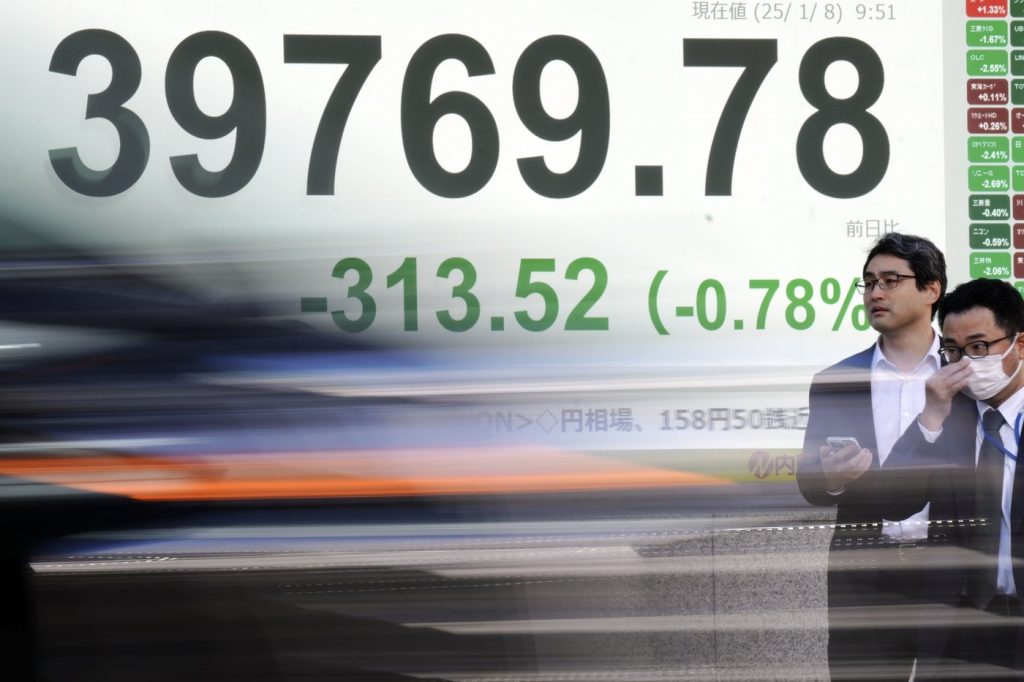Asian markets experienced a mostly downward trend on Wednesday following a steep decline on Wall Street, despite positive indicators from the U.S. jobs market and business activity reports. U.S. futures and oil prices were on the rise, suggesting a mixed outlook among investors.
In Japan, the benchmark Nikkei 225 remained unchanged at 40,079.09. The Japanese yen weakened against the dollar, trading at 158.19 yen, a slight increase from the previous rate of 158.06. Meanwhile, Hong Kong's Hang Seng index fell by 1.6% to 19,137.88, and the Shanghai Composite index saw a drop of 1.5% to 3,182.49. Notably, shares of Tencent decreased by 2.1%, while CATL, the world's largest battery manufacturer, experienced a 1.4% drop. This was attributed to their inclusion in a U.S. Defense Department list that linked them to China's military activities.
Amid growing tensions, uncertainties have emerged for the world's second-largest economy, especially with the impending presidency of Donald Trump, slated to take office on January 20. His administration is expected to impose potential tariffs and introduce policy changes that could significantly impact China's economic landscape.
Conversely, South Korea's Kospi index showed a resilience by jumping 1.2% to 2,522.75, while Australia’s S&P/ASX 200 climbed 0.7% to close at 8,348.60.
On Wall Street, the performance was notably negative on Tuesday, with the S&P 500 dipping 1.1% to 5,909.03 after initially gaining, while the Dow Jones Industrial Average and the Nasdaq composite suffered losses of 0.4% and 1.9%, respectively. Investors reacted to increasing yields in the bond market, which spiked following the release of encouraging economic reports. One report indicated that U.S. employers were advertising more job openings at the end of November than anticipated, while another revealed that business activity in sectors such as finance and retail grew significantly faster in December than expected.
These strong indicators may be good news for job seekers and those concerned about a potential recession; however, they could contribute to persistent inflationary pressures. This scenario might discourage the Federal Reserve from implementing further interest rate cuts that Wall Street typically favors. The Fed commenced its interest rate cuts in September, aiming to stimulate the economy but has signaled a slowdown in this easing procedure.
The looming threat of tariffs introduced by President-elect Trump has also raised concerns about additional inflationary pressures, with inflation rates staying just above the Fed’s target of 2%. Furthermore, a report from the Institute for Supply Management (ISM) indicated that price increases in the U.S. services industry accelerated in December, reinforcing fears of rising inflation.
As expectations for fewer interest rate cuts in 2025 gain traction, longer-term Treasury yields have surged, partly due to apprehensions over potential Trump policies such as tax cuts that could exacerbate U.S. government debt levels. Rising yields make Treasury bonds more appealing to investors, which consequently exerts downward pressure on stock prices.
The yield on a 10-year Treasury bond increased from 4.63% to 4.69% immediately following the favorable economic reports and has risen from just 4.15% in early December. Analysts from Bank of America have suggested that the market appears to be shifting to a ‘good news is bad news’ dynamic, especially as worries regarding a slowing U.S. economy dissipate.
The upcoming U.S. job market update on Friday is anticipated with heightened focus, as economists project a slowdown in job growth, estimating an addition of 156,500 jobs in December, according to FactSet.
In energy trading, benchmark U.S. crude oil saw an increase of 37 cents, reaching $74.62 per barrel, while Brent crude rose by 29 cents to $77.34 per barrel. In the currency markets, the euro rose to $1.0347, a slight increase from $1.0341.










